
Cycle Through Ancient Japan: Asuka Village Day Trip from Osaka/Kyoto
- Written by: LIVE JAPAN Editor
When you think of Nara, deer may come to mind—but venture a little farther south and you’ll discover Asuka Village, a peaceful countryside treasure steeped in 1,400 years of history. Once the political heart of Japan’s Asuka period, this area is dotted with ancient tombs, ruins, and folklore. But don’t let the history intimidate you—Asuka is full of natural beauty and charming streets, making it a true hidden gem.
Hop on a train from Osaka or Kyoto to Kintetsu-Asuka Station, rent an electric bike, and take your time exploring rice fields and historic sites at your own pace. It’s a refreshing escape that blends nature and nostalgia in the most scenic way.
Love photography, countryside charm, and avoiding tourist crowds? Then Asuka Village is a must for your next day trip. Here’s a peek at our favorite cycling route and the surprises we found along the way.
(This article includes sponsored content)
- Table of Contents
-
- Getting to Asuka Village: Access & Tour Info
- First Stop at Asuka Station: Pick Up Maps & Travel Tips for a Smooth Visit
- First Stop: Takamatsuzuka Tomb—Meet the Famous Asuka Beauties
- Kameishi: A Cute-Looking Stone with a Creepy Legend
- Inabuchi Terraced Rice Fields: A Living Canvas of the Seasons
- Step into history across stepping stones: Asuka River Stepping Stones
- Step Inside the Mighty Ishibutai Kofun—One of Japan’s Largest Burial Mounds
- Taste Ancient Rice at Yumeichi Chaya, a Farmhouse Restaurant Near Ishibutai Kofun
- Visit the Ancient Asuka-dera Temple: Japan's Oldest Temple and Buddha Statue
- Bonus Tip: Stay the Night in Asuka Village
Getting to Asuka Village: Access & Tour Info
Getting to Asuka Village from Kyoto or Osaka is easier than you might think—and perfect for a relaxed day trip. From either city, simply transfer at Kashiharajingu-mae Station, then hop on the Kintetsu Yoshino Line to Asuka Station, and you’re there!
To save on transportation and enjoy more flexibility, consider picking up one of the following convenient passes.
- Kintetsu Rail Pass: Offers wide coverage and unlimited rides on Kintetsu Railway lines—especially convenient for travelers coming from Kyoto or Osaka.
- KANSAI RAILWAY PASS: Includes rides on multiple private railways and buses, ideal for those planning a multi-day Kansai trip.
- Asuka Ancient Romance 1-Day Ticket (古代ロマン 飛鳥 日帰りきっぷ): Designed for day-trippers, this value-packed pass covers both train fare and local bus rides in the Asuka area.
After arriving at Asuka Station, you can choose to explore the area by sightseeing bus, hop on the local “Akakame” Asuka Loop Bus, or rent an electric bicycle.
For this trip, we opted for an electric bike—perfect for setting your own pace and weaving freely between rice fields, ancient tombs, and historic landmarks. It’s a relaxing and flexible way to take in the rich history and natural beauty of Asuka Village.
First Stop at Asuka Station: Pick Up Maps & Travel Tips for a Smooth Visit
To reach Asuka Village, take the Kintetsu Line—about 1 hour from central Nara’s Kintetsu-Nara Station or roughly 40 minutes from Osaka Abenobashi Station via limited express or rapid trains—to arrive at Kintetsu Asuka Station, the nearest station to the village.
Once you exit the plaza in front of the station, head straight to the Asuka Bitono-kan Tourist Information Center. It’s the perfect place to grab sightseeing maps, local travel tips, and discount info to help you make the most of your visit.


One of the main reasons to visit the Asuka Bitono-kan is to pick up the Asuka Kingdom Tourist Passport (飛鳥王国パスポート)—a handy guidebook available for just 100 yen (tax included). This compact booklet helps you explore the village efficiently and includes discount coupons for various attractions, temples, and historical sites. It’s a great-value travel companion packed with local perks!


-
Asuka Bitono-kan飛鳥びとの館
- Address ・Address: 6-3 Oaza Koshiji, Asuka Village, Takaichi District, Nara Prefecture 634-0138
・Hours: 8:30 AM–5 PM (subject to seasonal changes)
・Closed: Year-end and New Year holidays
- Recommended departure time: 8 AM from Kyoto/Osaka
- From Kyoto Station, take the Kintetsu Express → transfer at Kashiharajingu-mae to Asuka Station (about 1 hour 40 minutes)
- From Osaka Abenobashi Station → transfer at Kashiharajingu-mae to Asuka Station (about 1 hour 20 minutes)
- Electric bicycle (rental locations within walking distance from Asuka Station) is the top recommendation, balancing scenery and flexibility
- Asuka Loop Bus: Ideal for travelers who prefer not to cycle, with fixed routes stopping at major sights
- Driving: Suitable for travelers with an international driver's license, but note that village roads are narrow and have lower speed limits
Asuka Village is part of the Asuka Historical National Government Park, which is divided into five main areas, including the Takamatsuzuka Area and the Ishibutai Area. Given the park’s wide expanse, getting around by bicycle is much more efficient and comfortable than walking.
Just steps from Asuka Station, you’ll find the Asuka Rental Cycle – Asuka Station Branch right in the station plaza—perfect for picking up a bike. Since the village is dotted with gentle hills and slopes, we highly recommend renting an electric bicycle for an easier ride.
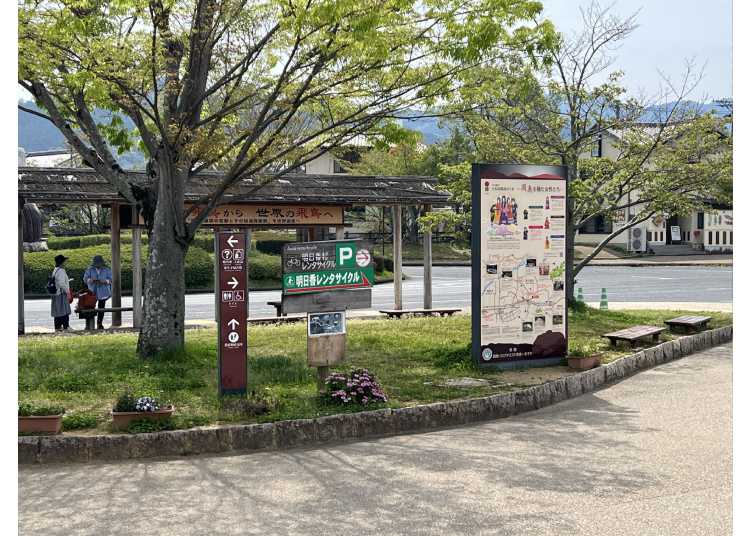
The Asuka Rental Cycle – Asuka Station Branch is just a short walk from Kintetsu Asuka Station. After exiting the station, simply look to your right—you’ll spot the rental shop’s signboard right away. Follow it, and you’ll be there in no time!
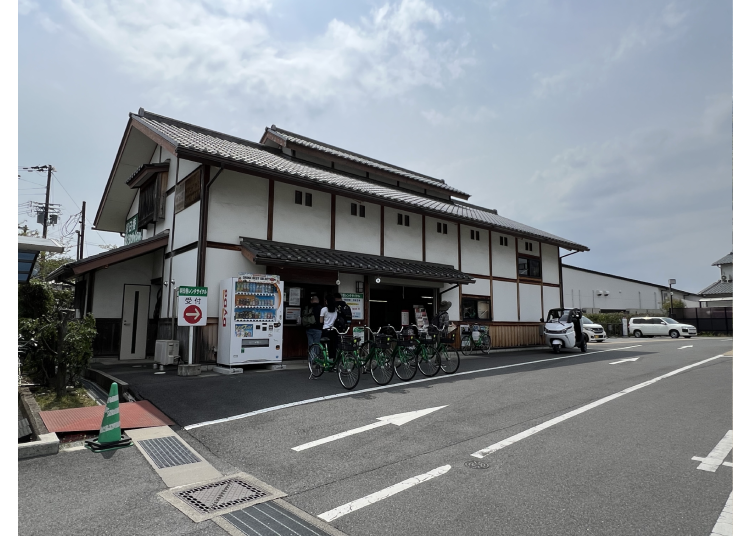

Rental prices are as follows:
・Standard bicycle: 1,200 yen
・Electric bicycle: 1,700 yen
Motorbikes are also available.
Opening hours are from 9 AM to 5 PM, so be sure to return your rental by closing time!


-
Asuka Rental Cycle (Asuka Station Branch)明日香レンタサイクル(飛鳥駅前営業所)
- Address 13-1 Oaza Koshiji, Asuka Village, Takaichi District, Nara Prefecture 634-0138
・Hours: 9 AM–5 PM
・Closed: Open daily
First Stop: Takamatsuzuka Tomb—Meet the Famous Asuka Beauties
Our first destination is Takamatsuzuka Kofun and the Takamatsuzuka Mural Museum, just a 10-minute bike ride from Asuka Station. Pedaling through lush greenery and peaceful rice fields, we set off under a gentle, refreshing breeze—it’s a relaxing and scenic start to the journey!

Takamatsuzuka Kofun was discovered in 1962 when a local resident was digging soil to store ginger. This two-tiered round burial mound was built between 694 and 710, during the late Asuka period.
The identity of the person buried here remains uncertain, but three theories exist: a prince of Emperor Tenmu, a high-ranking official named Ishikami Maro, or a member of the Korean royal family who came to Japan.

Inside the tomb is a single burial chamber, where vibrant wall paintings were discovered during an archaeological survey in 1972. While the original murals have since been relocated for preservation and study, the adjacent Takamatsuzuka Mural Museum features beautifully crafted reproductions.
Let’s head over and take a closer look at these remarkable artworks!
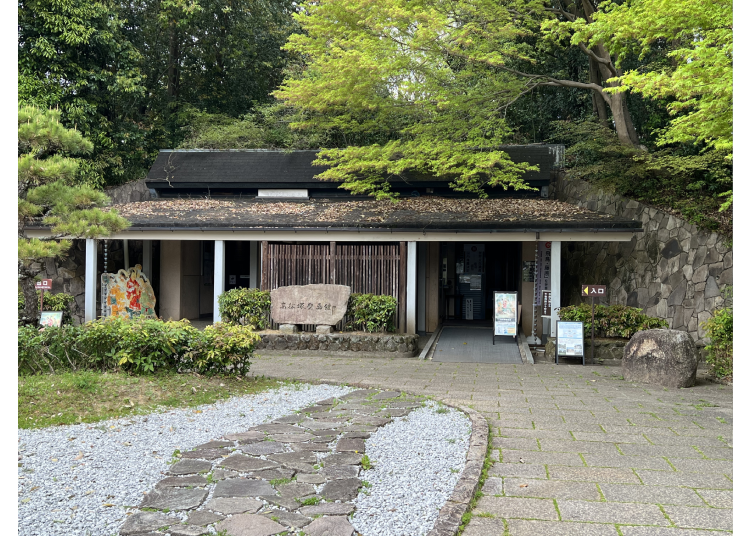
The tomb walls are believed to have been decorated with images of the Four Symbols from Chinese mythology: Black Tortoise (north), Azure Dragon (east), White Tiger (west), and Vermilion Bird (south). Unfortunately, the mural of the Vermilion Bird on the southern wall was lost to grave robbers.
Inside the museum, you can view detailed reproductions of all four wall paintings, along with burial artifacts that were miraculously spared. While photography is normally prohibited, special permission was granted for us to take pictures during this visit!


The vivid wall paintings of elegantly dressed men and women brought fame to Takamatsuzuka Kofun, transforming it into a major tourist attraction. Among them, the four graceful female figures—known as the Asuka Beauties—are especially admired for their refined and colorful depiction.

The painting is so vivid, it feels as if you can almost hear the women’s gentle laughter and breathing. For a moment, the world of 1,400 years ago feels astonishingly close.
-

-
Address
439, Hirata, Asuka-mura, Takaichi-gun, Nara, 634-0144
View Map -
Nearest Station
Asuka Station (Kintetsu-yoshino Line)
4 minutes on foot
- Phone Number 0744-54-3340
-
Address
439, Hirata, Asuka-mura, Takaichi-gun, Nara, 634-0144
Kameishi: A Cute-Looking Stone with a Creepy Legend
In addition to burial mounds and historic ruins, Asuka Village is also dotted with mysterious megaliths tied to local legends—such as Sakafune-ishi and Oni no Manaita. One such site, Kameishi (Turtle Stone), is just a 15-minute bike ride from Takamatsuzuka Kofun.

Kameishi is a large granite stone with a face-like carving on its front. Though it originally faced north, it now mysteriously points southwest. According to local legend, if the stone ever turns fully west, the entire Yamato region (present-day Nara Basin) will sink into a sea of mud!

With its relaxed, sunbathing-like expression, it’s hard to believe this gentle-looking stone is tied to such a chilling legend. Let’s hope it stays right where it is—peacefully facing the same direction for years to come!
-
Kameishi亀石
- Address 108 Oaza Kawahara, Asuka Village, Takaichi District, Nara Prefecture 634-0141
Hours: Open anytime
Inabuchi Terraced Rice Fields: A Living Canvas of the Seasons
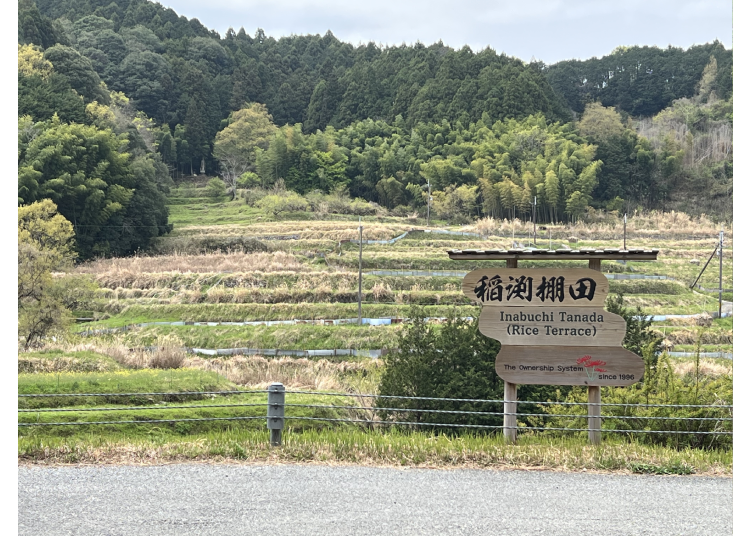
No visit to Asuka Village is complete without seeing the Inabuchi Tanada terraced rice fields. These beautifully layered paddies cascade down the hillside, transforming with each season. It’s a favorite spot for photographers and travelers looking to soak in rural Japan at its most scenic.
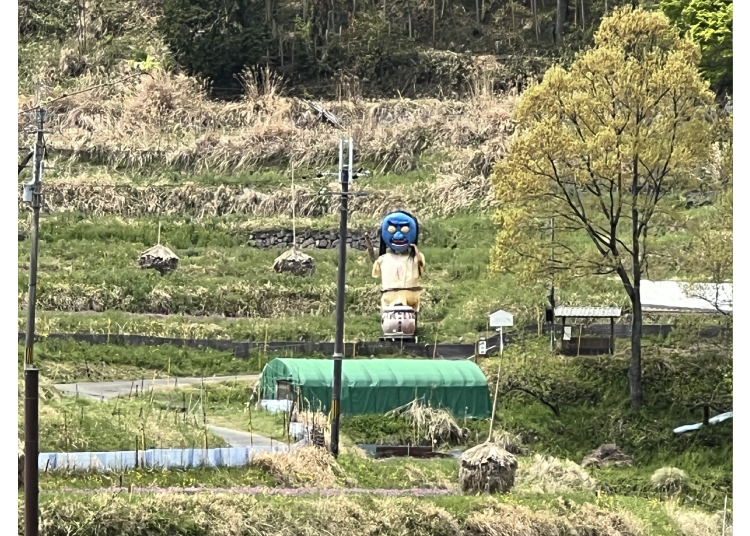
In autumn, the Kakashi Matsuri (Scarecrow Festival) brings these fields to life, as villagers and students craft scarecrows in the form of anime characters, pop culture figures, and more. It adds a playful charm to the peaceful countryside. Even outside the festival season, a walk along the terraces offers a heartwarming glimpse into the harmony between nature and daily life in Asuka Village.
-
Inabuchi Terraced Rice Fields稲渕の棚田
- Address Inabuchi, Asuka Village, Takaichi District, Nara Prefecture 634-0112
Hours: Open anytime
Step into history across stepping stones: Asuka River Stepping Stones
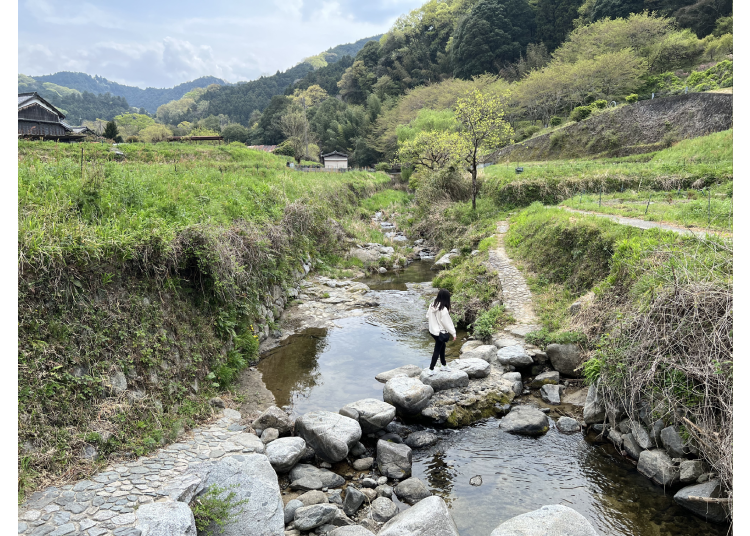
Just a short walk from the Inabuchi terraced fields brings you to the Asuka River, where you’ll spot large stepping stones thoughtfully placed across the water—these are the famous Asukagawa Tobi-ishi (stepping stones). Found in both the upper and lower reaches of the river, these stones were originally set to help villagers cross the stream easily, but today they’ve become a charming photo spot and a delightful surprise for walkers.
The stones also appear in a poem from the ancient Manyoshu anthology:
"Asukagawa, ashita mo wataran ishibashi no / tooki kokoro wa omoe muku kamo"
("Tomorrow, I’ll cross this stone bridge again over the Asuka River. My heart, like these close-set stones, stays ever near to yours.")
Using the stepping stones as a symbol of enduring connection, this verse beautifully reflects the delicate and heartfelt emotions often found in Japanese poetry.
-
Asuka River Stepping Stones飛鳥川の飛び石
- Address Oka, Asuka Village, Takaichi District, Nara Prefecture 634-0111
Step Inside the Mighty Ishibutai Kofun—One of Japan’s Largest Burial Mounds
A 15-minute bike ride from Kameishi brings you to the impressive Ishibutai Kofun, the largest rectangular stone tomb in Japan. Built during the Asuka period, it’s believed to be the final resting place of Soga no Umako, a powerful statesman and contemporary of Prince Shotoku.
Because records confirm a burial once took place here, it’s also known as Umako’s Tomb (馬子の墓), adding even more historical weight to this monumental site.

Unlike most burial mounds built by piling up earth, Ishibutai Kofun is a massive exposed-style horizontal stone chamber, featuring a passageway leading to the inner burial room. The flat, stage-like top of the stone structure gives it its name—Ishibutai, or "stone stage"—a name it has held since ancient times.

Among the massive stones, the two slabs forming the ceiling are especially striking—the northern one weighs an estimated 64 tons, while the southern one weighs about 77 tons. In total, the entire tomb is made up of over 30 stones weighing approximately 2,300 tons!
Believed to have been built in the early 7th century, long before the advent of cranes or machinery, every stone was transported using only human power. It’s a powerful testament to the remarkable engineering and construction techniques of the time.

One of the highlights of Ishibutai Kofun is that you can actually step inside. Let’s head in and explore this ancient stone chamber up close!


Inside the tomb lies the gen-shitsu (main burial chamber), where the coffin was once placed. The chamber measures approximately 4.8 meters high, 7.6 meters deep, and 3.5 meters wide. Overhead, the massive capstones that form the ceiling of Ishibutai Kofun let in faint rays of light through the stone gaps, adding a mysterious glow to this ancient space.

Although no complete stone coffin was found during excavation, fragments believed to be part of a sarcophagus were discovered—adding to the mystery surrounding this ancient tomb.
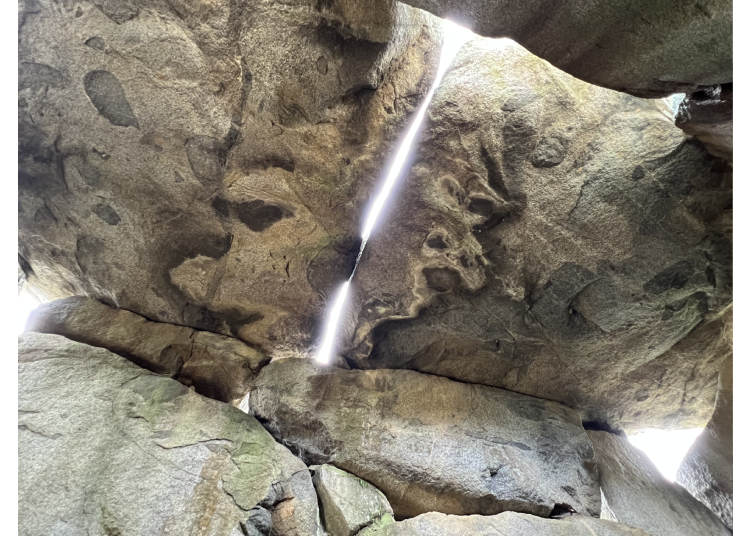

Seeing the legendary Ishibutai Kofun up close was a powerful experience—the sheer scale of the stones was overwhelming. Standing inside the solemn burial chamber, I could feel a mysterious energy that made the moment truly unforgettable.
-

-
Address
254, Shimasho, Asuka-mura, Takaichi-gun, Nara, 634-0112
View Map -
Nearest Station
Kashiharajingumae Station (Kintetsu Minami-Osaka Line / Kintetsu-kashihara Line / Kintetsu-yoshino Line)
27 minutes by bus
- Phone Number 0744-54-4577
-
Address
254, Shimasho, Asuka-mura, Takaichi-gun, Nara, 634-0112
Taste Ancient Rice at Yumeichi Chaya, a Farmhouse Restaurant Near Ishibutai Kofun
Just a short walk from Ishibutai Kofun, several cozy dining spots await. One standout is Noson (Farmhouse) Restaurant Yumeichi Chaya, a charming farmhouse-style eatery run by local mothers. Here, you can enjoy seasonal vegetable dishes and a special ancient rice set meal that captures the natural flavors of Asuka.
Ancient rice refers to heirloom strains that retain characteristics of wild rice—possibly the same kind eaten during Prince Shotoku’s time! The restaurant also features a local goods shop on the first floor, Asuka no Yumeichi, perfect for a bit of post-lunch browsing.



The restaurant offers delicious dishes made by local housewives, with a menu full of popular choices. Among them, I decided to try the most beloved dish, the Ancient Rice Set Meal, which showcases the natural flavors of the region.
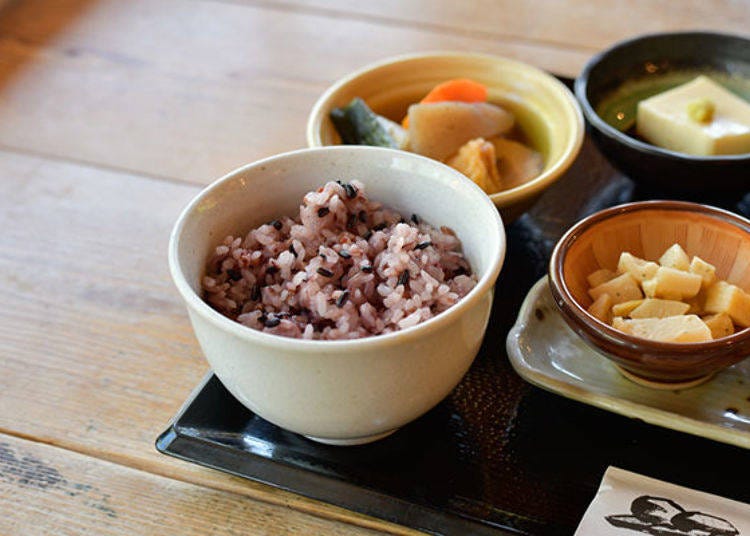
The Ancient Rice Set Meal is a fulfilling dish centered around ancient rice. In addition to the rice, the meal includes 7 delicious sides like fried chicken, stewed vegetables made from locally grown seasonal produce, and refreshing salads. The plate is also accompanied by homemade pickled ginger and Asuka Ruby strawberries, a local delicacy.
After taking a bite of the ancient rice, I was impressed by its chewy, glutinous texture with a slight fluffiness. The rice was sweet and delicious! Another highly praised item, just like the ancient rice, is the restaurant’s handmade koyudofu (silken tofu).

After taking a bite, the rich, smooth koyudofu had a delightful, sticky texture that glided down my throat easily—honestly, I could have eaten even more! Since this tofu is not available as an à la carte dish, nor sold as a souvenir, the only way to enjoy this highly praised tofu is by ordering the Ancient Rice Set Meal.
In addition to the tofu, the restaurant also serves a variety of delicious handmade dishes, such as the popular Black Rice Curry. Be sure to try other mouthwatering meals on the menu as well!

-
Yumeichi Chaya農村レストラン 夢市茶屋
- Address ・Address: 154-3 Oaza Shimasho, Asuka Village, Takaichi District, Nara Prefecture 634-0112
・Hours: 11 AM–4 PM (extended to 5 PM on Saturdays and Sundays)
・Closed: Year-end and New Year holidays
Discover Another Gem: A Stylish Café Hidden in Asuka!
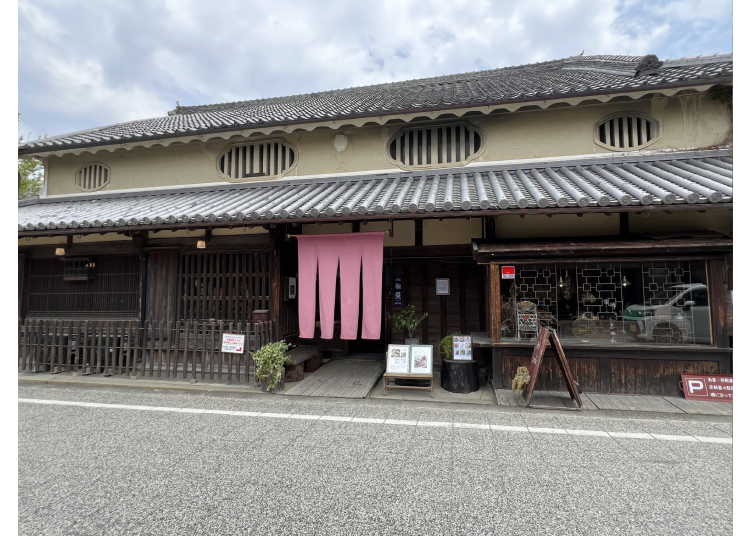
Just a 5–10 minute bike ride from Ishibutai Kofun, Café Kotodama is nestled in a nostalgic, traditional street and housed in a 200-year-old folk house. The café offers a menu featuring lunch, handmade desserts, and coffee, all served in a peaceful, relaxing environment perfect for unwinding.
I originally expected the area to be more rustic and understated, but to my delight, I stumbled upon this stylish and charming café, hidden like a secret oasis. Not only is the ambiance enchanting, but the food is delicious too!
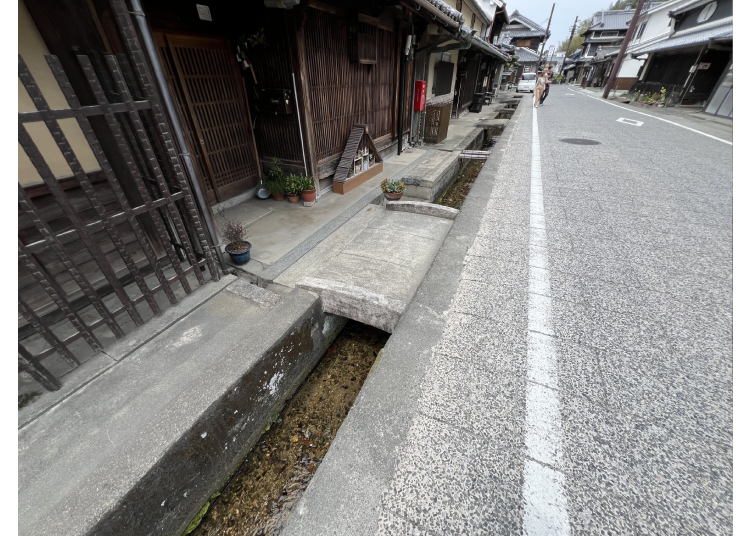
Visit the Ancient Asuka-dera Temple: Japan's Oldest Temple and Buddha Statue
If you have extra time, I highly recommend cycling about 15 minutes from Ishibutai Kofun to visit Asuka-dera Temple. Completed in the year 596 after around eight years of construction, Asuka-dera was founded by Soga no Umako to protect Buddhism and is the oldest authentic Buddhist temple in Japan. It’s a must-see for those interested in the roots of Japanese Buddhism!

When Asuka-dera was first built, it was a grand Buddhist temple with three main halls surrounding a central pagoda and an outer corridor. The construction involved architects from Baekje, a kingdom on the Korean Peninsula, who brought their advanced building techniques. As Buddhism spread from China to Japan, the temple’s design and the new techniques and art that accompanied it deeply influenced the architecture of temples across Japan. Interestingly, Asuka-dera was also the first in Japan to use tile roofing, marking an important step in the country’s architectural evolution.

Inside the main hall is Japan’s oldest Buddha statue, the seated statue of Shakyamuni, commonly known as the Asuka Daibutsu. This statue was commissioned by Empress Suiko, Japan’s first female emperor, and built by Prince Shotoku and Soga no Umako. It was crafted by the renowned artisan Kuratsukuri no Tori, making it a significant piece of Japan’s early Buddhist heritage.

Compared to other Buddha statues in Japan, the Asuka Daibutsu has a more delicate, slender face and a prominent nose, reflecting the influence of Korean and Chinese styles. What’s fascinating is that when viewed from the right, the statue appears solemn and serious, but from the left, it looks gentle and peaceful. Having stood in the same spot for over 1,400 years, it’s possible that Empress Suiko and Prince Shotoku may have visited the statue, just like we do today!

Inside the temple, you’ll find a variety of excavated artifacts, including tiles and other relics. After exploring the collection, take a short 70-meter walk from the temple’s west gate to see the Gorin-tō, also known as the Iruka no Kubizuka (Iruka's Tomb), a five-story pagoda with a fascinating historical background.

The name Iruka refers to Soga no Iruka, the descendant of Soga no Umako, who is buried in Ishibutai Kofun. According to legend, after the Isshi no Hen (the Isshi Incident), Prince Naka-no-Ōe and Nakatomi no Kamatari executed Soga no Iruka at the Imperial Palace—about 500 meters south of Asuka-dera—and his severed head is said to have flown to this very spot.
This event paved the way for the famous Taika Reform, one of Japan’s most significant political changes!

During our visit, we encountered a steady flow of visitors, including school groups, tour groups, and solo travelers. The more you learn about Asuka-dera’s history and legends, the more meaningful the experience becomes. With its rich heritage, Asuka-dera is undoubtedly a must-visit spot in the Kansai region, joining other magnificent temples in Kyoto and Nara.
From Asuka-dera Temple, it takes about 20 minutes to bike back to the starting point at Asuka Station. Asuka Village, with its tranquil and scenic countryside, was once the heart of Japan’s political power 1,400 years ago, just as modern Tokyo is today. During the mid-Asuka period, the first era name, Taika, was established, and by the end of the Taika era, the country officially changed its name from "Yamato" to "Nihon" (Japan).
-

-
Address
682, Asuka, Asuka-mura, Takaichi-gun, Nara, 634-0103
View Map -
Nearest Station
Kashiharajingumae Station (Kintetsu Minami-Osaka Line / Kintetsu-kashihara Line / Kintetsu-yoshino Line)
19 minutes by bus
- Phone Number 0744-54-2126
-
Address
682, Asuka, Asuka-mura, Takaichi-gun, Nara, 634-0103
Bonus Tip: Stay the Night in Asuka Village
If you have the time and want to fully immerse yourself in the serene beauty of this ancient village, I highly recommend spending a night in Asuka. After the day’s visitors have left, the village returns to its peaceful state. Whether cycling through golden rice fields at dusk or waking up to the sound of birdsong at dawn, you’ll experience the purest essence of this land. Many guesthouses retain the charm of traditional folk houses, offering meals made with local ingredients. This allows you to deeply experience the joy of "living in Asuka" through all your senses. A night here offers a true slow travel experience, allowing you to discover that Asuka’s true charm lies in the unhurried, everyday moments.
Here are some selected guesthouses and accommodations in traditional houses.
-

-
Address
川原63 まほろの宿, Asuka, Nara, 634-0141
View Map -
Nearest Station
Okadera Station (Kintetsu-yoshino Line)
30 minutes on foot
Vacancy search, reservation
-
from 23,800JPY 1room, 2adults
Check with our partner site as the latest rates, rate details, and guest room requirements may vary.
-
Address
川原63 まほろの宿, Asuka, Nara, 634-0141
-

-
Address
明日香村飛鳥618−2, Asuka, Nara, 634-0103
View Map -
Nearest Station
Okadera Station (Kintetsu-yoshino Line)
44 minutes on foot
Vacancy search, reservation
-
from 31,680JPY 1room, 2adults
Check with our partner site as the latest rates, rate details, and guest room requirements may vary.
-
Address
明日香村飛鳥618−2, Asuka, Nara, 634-0103
-

-
Address
136, Asuka, Nara, 634-0124
View Map -
Nearest Station
Tsubosakayama Station (Kintetsu-yoshino Line)
Vacancy search, reservation
-
from 52,364JPY 1room, 2adults
Check with our partner site as the latest rates, rate details, and guest room requirements may vary.
-
Address
136, Asuka, Nara, 634-0124
-

-
Address
Mayumi 1473, Asuka, Nara, 634-0137
View Map -
Nearest Station
Asuka Station (Kintetsu-yoshino Line)
11 minutes on foot
Vacancy search, reservation
-
from 44,000JPY 1room, 2adults
Check with our partner site as the latest rates, rate details, and guest room requirements may vary.
-
Address
Mayumi 1473, Asuka, Nara, 634-0137
-

-
Address
9-11 oka AsukaMura Asuka no yado, Asuka, Nara, 634-0111
View Map -
Nearest Station
Asuka Station (Kintetsu-yoshino Line)
38 minutes on foot
Vacancy search, reservation
-
from 18,709JPY 1room, 2adults
Check with our partner site as the latest rates, rate details, and guest room requirements may vary.
-
Address
9-11 oka AsukaMura Asuka no yado, Asuka, Nara, 634-0111
-

-
Address
564 Sakada, Asuka Village, Takaichi District, Nara 634-0122, 634-0122
View Map -
Nearest Station
Asuka Station (Kintetsu-yoshino Line)
-
Address
564 Sakada, Asuka Village, Takaichi District, Nara 634-0122, 634-0122
Visiting Asuka Village offers a chance to feel the pulse of Japan's ancient culture while experiencing a slower, more peaceful pace of life, far removed from the hustle and bustle of the city. Whether cycling through historic ruins, stepping across stepping stones that evoke the poetry of the Manyoshu, or quietly savoring local flavors in a traditional guesthouse café, every moment in Asuka is filled with the village’s unique charm. Just an hour by train from Osaka or Kyoto, this tranquil land is perfect for a one-day getaway.
If you’re looking for a deeper journey that combines history, nature, and countryside views, consider adding Asuka Village to your next Japan itinerary!
Lastly, here are some convenient transportation passes and chartered services in Kansai to make your travels even more flexible and enjoyable.
The LIVE JAPAN editorial team is a multinational group made up of native editors who have lived in Japan for over five years and Japanese editors who love to travel. Together, we share the best of Japan, offering cultural insights, historical context, event updates, and travel-friendly deals, to support your journey every step of the way.
- Area
- Category
*Prices and options mentioned are subject to change.
*Unless stated otherwise, all prices include tax.
Popular Tours & Activitiess
Recommended places for you
-
Goods

Yoshida Gennojo-Roho Kyoto Buddhist Altars
Gift Shops
Nijo Castle, Kyoto Imperial Palace
-

Kambei Sannomiyahonten
Yakiniku
Kobe, Sannomiya, Kitano
-

To-ji Temple
Temples
Kyoto Station, To-ji Temple
-

Kanzenkoshitsuyakinikutabehodai Gyugyu Paradise Sannomiya
Yakiniku
Kobe, Sannomiya, Kitano
-

Jukuseiniku-to Namamottsuarera Nikubaru Italian Nikutaria Sannomiya
Izakaya
Kobe, Sannomiya, Kitano
-

ISHIDAYA Hanare
Yakiniku
Kobe, Sannomiya, Kitano
-

November Events in Kansai: Fun Festivals, Food, and Things to Do in Kyoto & Osaka
-

Everything You Need to Know About teamLab Biovortex Kyoto (2025 Insider Guide)
by: Wemmy Chau
-
Ad

Discover Timeless Beauty: Kimono-en, a Web Magazine Exploring the Spirit of Kimono
-

Celebrate a Dreamy Barbapapa Christmas at JR Osaka Station's Twilight
by: Guest Contributor
-
Ad

Recharge and Relax with a Healing Getaway at Kamenoi Hotel Toba
-

Curious About Sake? I Visited a Sake Brewery in Japan and Here's What I Learned
Inspiration for Accommodations
-

Spacious Family Hotel in Namba: 20 Comfortable Stays for Family Fun
-

Charming Hotels to Enjoy the Spectacular Views of Arashiyama's Autumn Leaves from Your Room
-

Experience Stunning Views of Osaka Castle from Private Spaces: Top Hotels Near Osaka Castle
-

Recommended by Visitors! Arashiyama's Best-Rated Hotels
-

Family-Friendly Universal Studios Japan Hotel with Excellent Access
-

Enjoy a Comfortable Stay in Osaka! 10 Hotels with Convenient Airport Shuttle Services
-

Top 10 Recommended Hotels Near Namba Station with Great Access
-

Enjoy Night Views from Your Room! Recommended Hotels in Namba Area
-
Ad

Traveling from Osaka to Beppu? Enjoy a Comfortable, Relaxing Ferry Journey
-
Ad

See Kyoto with Ease on a Rentacycle! How to Enjoy Sightseeing by Bike & Rules/Manners You Should Know
-

15 Exciting Tours to Experience the Best of Osaka
by: Himanshi Shah
-

Dining in Kyoto: Best Restaurants for Kaiseki, Sushi, Cafes & More
-

(Video) Walking Tour along Narita Omotesando - Quaint Historical Village near Narita Airport!
by: Victor Gonzalez
-

5 Popular Shops and Gift Ideas Along Arashiyama Shopping Street
- #best gourmet Osaka
- #things to do Osaka
- #what to do in kyoto
- #what to bring to japan
- #best gourmet Kyoto
- #new years in Osaka
- #what to buy in nanba
- #Visiting Osaka
- #onsen tattoo friendly arima
- #daiso
- #Visiting Kyoto
- #best japanese soft drinks
- #japanese fashion culture
- #japanese convenience store snacks
- #japanese nail trends




















